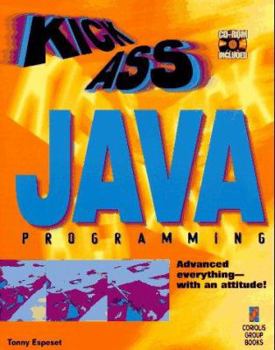Kickass Java Programming: Cutting-Edge Java Techniques With an Attitude
One of the features of this work, which concentrates on sound and animation in Java, is to shows users how to generate animations after a small image is transferred - advanced animation at a fraction... This description may be from another edition of this product.
Format:Paperback
Language:English
ISBN:1883577993
ISBN13:9781883577995
Release Date:August 1998
Publisher:Coriolis Group
Length:512 Pages
Weight:1.90 lbs.
Dimensions:9.3" x 1.3" x 7.8"
Customer Reviews
4 ratings
Amazing Book
Published by Thriftbooks.com User , 16 years ago
I have had this book since 1998, and I use it time and time again for reference on image manipulation. I've successfully ported the algorithms in C++ and now ActionScript 3 (flash); it works amazingly well! Perfect also for whoever wants to understand how 3D engines (basic ones) work. Although it is in Java, you can easily port the code to any other language. His explanations are concise, simple and of exceptional quality! Very very recommended for anyone who likes to experiment with animations, 3d & 2d engines and image manipulation.
Outstanding old book on imaging algorithms in Java
Published by Thriftbooks.com User , 19 years ago
Don't let the age of this book fool you. It is basically all about the algorithms necessary for producing visual effects in both 2D and 3D that just happens to use Java as an implementation language. The first chapter is titled "Easy Animation." The chapter's main focus is creating quickly loaded images, and reducing flicker. Chapter two covers sound and is eight pages long. Two pages are sample code. Remember this book was written when Java had very primitive sound support. Chapter three goes deep into image processing. The end result is that this chapter shows you how to code many of the special effects found in PhotoShop. Wave, ripple, and explode filters and 3D button effects among others are included here. To me this chapter is the one that stands the test of time the best due to all of the algorithms shown. Chapter four covers two-dimensional rendering. The main topic of this chapter is creating small animations based on single pictures. The author introduces his framework class "ImageProcessor" first in this chapter. Chapter five is entitled "Entering the Third Dimension". A really interesting star field program is included that was written, of course, before Java3D. Other programs include a bouncing ball and some take-offs of the star field. Then a 3D spiral program is introduced. The chapter dives back into the ImageProcessor class next. A program to break apart a picture and put it back together ends the chapter. Chapter six discusses the now obsolete VRML. 3D transformations, movement in 3D, and wire and shaded objects are all covered, quickly and with no sympathy for the novice. A full page and half is dedicated to a discussion of VRML. This is a lot for this book. Most topics get explained once, very quickly and then it's off to the next topic. Several pages are dedicated to explaining a turning cube script. The Matrix3D class is covered next. Navigation is covered briefly, and wireframes are introduced. Shading is covered very lightly then a truly monster program for a so-called "basic" Model3D class is given. This is twelve pages of code. A second program follows that allows you to view Model3D. The chapter ends with a discussion on precalculating movement and passing HTML to the VRML animator, which is also included. There are interesting ideas here, but VRML is old hat and the code will require adapting to more modern needs. Chapter seven is titled "Adding Realism." The main targets of this chapter are shading, illuminating, and textures--all, of course, very important to making that virtual world look real. The chapter walks through the creation of a cube in wire form then shows how to fill in the surfaces and begin shading. Shadows and perspective are discussed, then another little jewel is given. Listing 7.7 "Creating a 3D object from an image" and the accompanying viewer in 7.8 show how to take a title, make it 3D and shadow it. Texture is covered in great depth with lots of good code and more interesting tricks with pic
Excellent book
Published by Thriftbooks.com User , 23 years ago
Java games are a hobby of mine, and I must say this the most practical book for the topic that I've found. It contains great practical examples, and doesn't stray from the subject - programming techniques that allow you to produce excellent-looking applets. Ever see those flashy slideshow applets, with various special effects? This book will show you how to construct one by yourself, explaining each step with great detail. It goes through great extent in helping you understand what you're doing, all while sticking close to subject, without beating around the proverbial bush.The only downside to this book is its coverage of sounds in Java - if you need help with sounds and sounds alone, don't buy this book. It contains a miniscule amount of information regarding the subject - namely just a brief introduction to sounds, and usage of the Applet class' primitive audio playback functions (Java has great support for generating audio on-the-fly, which this book does not cover). Lack of detailed sound documentation doesn't take away the value of this book, however, and I recommend it to anyone who would like to produce "kickass java" applets.
Excellent advanced techniques and examples for writing games
Published by Thriftbooks.com User , 28 years ago
Firstly, as expected this book is not for the beginner programmer. It has excellent, working, examples which really takes you to the "cutting edge". Its focus is more on advanced animation (game-like programming techniques) and doesn't include for example database design and implementation, etc. Overall an excellent book, and for everyone bored with simple java UI's





